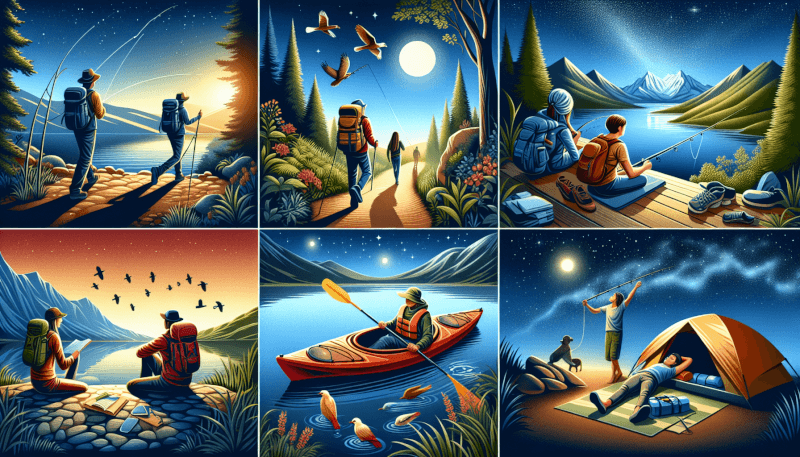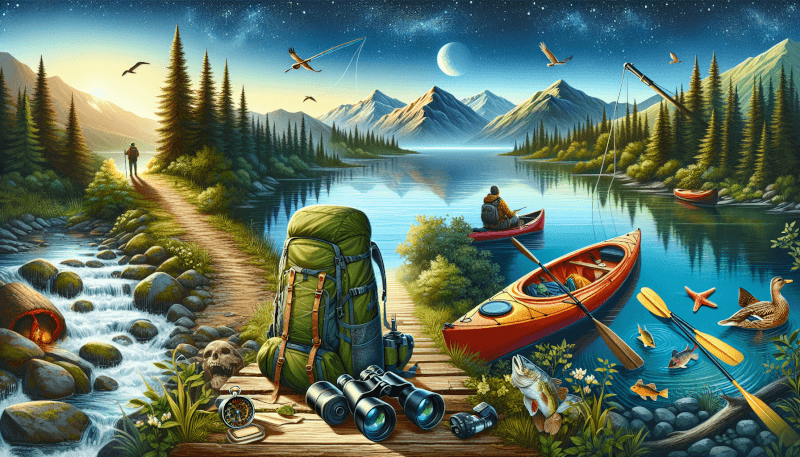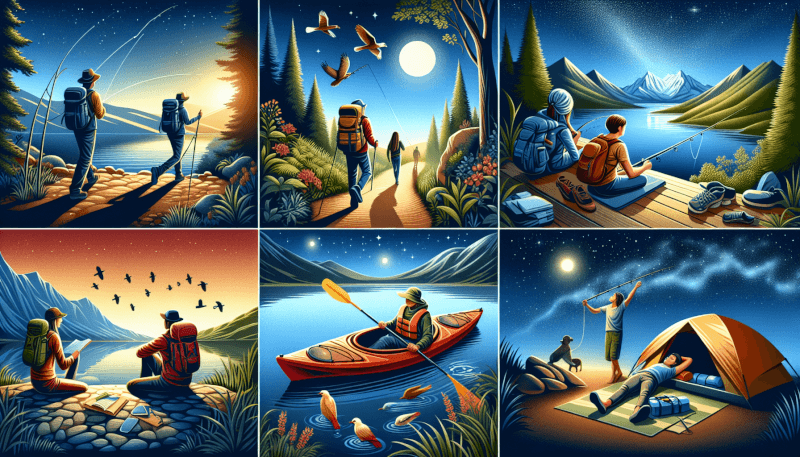Whether you’re a seasoned camper or new to outdoor adventures, there are plenty of activities to keep you entertained during your camping trip. From hiking and fishing to stargazing and campfire cooking, there’s something for everyone to enjoy. In this article, we will explore the most popular outdoor activities for camping, giving you ideas and inspiration to make the most out of your time in the great outdoors. So, grab your tent and embrace the beauty of nature as we embark on an exciting journey through the top outdoor activities for camping.

Hiking and Trekking
Hiking essentials
When it comes to hiking, there are a few essentials that you should always have with you. First and foremost, a good pair of hiking boots or shoes is essential to provide comfort and support for your feet. It’s also important to dress appropriately for the weather and terrain, wearing moisture-wicking clothing and layers that can be easily adjusted. Don’t forget to bring a backpack to carry water, snacks, a map, a compass, and a first aid kit. Lastly, sunscreen, insect repellent, and a hat are must-haves to protect you from the elements.
Choosing the right trail
Choosing the right trail for your hike is crucial to ensure an enjoyable and safe experience. Consider your fitness level and the amount of time you have available when selecting a trail. Beginners should start with shorter and easier trails, gradually working their way up to more challenging ones. Research the trail difficulty, elevation gain, and terrain to match your ability and preferences. Take into account the weather conditions and seasonal factors that may affect the trail, such as snow or heavy rainfall. Consulting with experienced hikers or using reliable hiking websites and guidebooks can provide valuable information about specific trails.
Tips for a successful hike
To have a successful hike, be prepared and follow these tips. Start by planning your hike ahead of time, including the route, estimated time, and any specific points of interest along the way. Always inform someone of your hiking plans, especially if you’re hiking alone, and check the weather forecast before setting off. Stick to marked trails and pay attention to any signs or warnings along the way. Take regular breaks to rest, hydrate, and refuel with snacks. Carry a map and compass, and know how to use them in case you lose your way. Lastly, leave no trace by packing out all trash and respecting the environment and wildlife around you.
Fishing
Freshwater fishing
Freshwater fishing is a popular activity enjoyed by many outdoor enthusiasts. It offers a wide variety of fish species to catch, such as bass, trout, and catfish. When freshwater fishing, it’s important to have the right equipment, including a fishing rod, fishing line, hooks, and bait. Different fish species require different techniques, so it’s essential to do some research beforehand to understand their behavior and feeding habits. Pay attention to local fishing regulations, as some areas may have catch limits or specific rules on what can be kept. Whether you’re fishing from the shore or a boat, always prioritize safety and be aware of your surroundings.
Saltwater fishing
Saltwater fishing provides a unique experience for anglers, with a wide range of fish species and a challenging environment. Whether you’re fishing from a pier, a beach, or a boat, it’s important to have the appropriate gear. Saltwater fishing requires stronger rods, reels, and lines to withstand the harsh conditions and the size and power of saltwater fish. Research the fish species you’re targeting, as their behavior and feeding patterns may vary depending on the location and time of year. Always check local regulations and obtain any necessary permits or licenses before heading out. And, of course, practice catch and release to preserve the fish population and the ecosystem.
Basic fishing techniques
Whether you’re a beginner or an experienced angler, mastering some basic fishing techniques can greatly improve your chances of success. The most common fishing techniques include casting, trolling, and fly fishing. Casting involves casting your line into the water and reeling it in, using different techniques to imitate the movement of prey and attract fish. Trolling is done from a slowly moving boat, with bait or lures dragged behind to entice fish. Fly fishing, on the other hand, uses a specialized lightweight fly rod and flies that mimic insects to catch fish. Each technique requires practice and an understanding of the fish’s behavior, so don’t be afraid to seek guidance from experienced anglers or take lessons to improve your skills.
Cycling
Mountain biking
Mountain biking is a thrilling outdoor activity that allows you to explore rugged terrains and enjoy breathtaking landscapes. When it comes to mountain biking, choosing the right bike is crucial. Look for a bike specifically designed for off-road trails, with features such as suspension, sturdy tires, and reliable brakes. Safety gear is also essential, including a properly fitted helmet, knee and elbow pads, and gloves. Before hitting the trails, familiarize yourself with your bike’s gears and practice proper riding techniques, such as shifting gears efficiently and using the brakes effectively. Start with beginner-friendly trails and gradually progress to more challenging ones, always prioritizing safety and enjoying the ride.
Road cycling
Road cycling is a popular activity that offers the opportunity to explore scenic routes and cover long distances. To get started, you’ll need a road bike that suits your budget and riding style. Road bikes are lightweight, have narrow tires, and are built for speed and efficiency on paved roads. It’s important to ensure that your bike is properly fitted to your body to avoid discomfort and prevent injuries. Safety is paramount, so invest in a quality helmet and wear high-visibility clothing to make yourself more noticeable to drivers. If you’re new to road cycling, start with shorter routes and gradually build up your endurance and distance. Remember to obey traffic laws and be alert to your surroundings at all times.
Choosing the right bike
Choosing the right bike depends on the type of cycling you plan to do and your personal preferences. Consider factors such as terrain, distance, riding style, and your budget. For mountain biking, look for a bike with full suspension if you’ll be riding on rough and technical trails, or a hardtail if you prefer a lighter and more efficient ride on less challenging terrain. Road bikes come in different styles, including endurance bikes for long-distance rides and racing bikes for speed and performance. Hybrid and commuter bikes are a popular choice for recreational riding and commuting. Visit a local bike shop to get expert advice and test different bikes to find the one that suits you best.
Canoeing and Kayaking
Choosing the right paddlecraft
When it comes to canoeing and kayaking, choosing the right paddlecraft is essential for a comfortable and enjoyable experience on the water. Consider factors such as your skill level, the type of water you’ll be paddling on, and the duration of your trips. Canoes are suitable for calm lakes and rivers, offering more stability and space for gear or multiple passengers. Kayaks, on the other hand, are available in different styles, including recreational kayaks for calm waters, touring kayaks for longer trips, and whitewater kayaks for more adventurous paddling. Sit-on-top kayaks are popular for beginners and warm weather paddling. Test different paddlecrafts and consult with experts to find the one that suits your needs and preferences.
Water safety tips
Water safety should always be a priority when participating in canoeing or kayaking activities. Start by wearing a properly fitted personal flotation device (PFD) at all times while on the water, regardless of your swimming ability. Familiarize yourself with the rules and regulations of the waterway you’ll be paddling on, including any specific motorboat traffic or navigational guidelines. Be aware of weather conditions and water levels, as they can affect the difficulty and safety of your paddle. Practice basic paddling techniques and learn how to perform self-rescue and assisted rescue techniques in case of capsizing or emergencies. Lastly, always let someone know your paddling plans and expected return time.
Exploring different waterways
One of the great advantages of canoeing and kayaking is the opportunity to explore different waterways and immerse yourself in nature. From calm lakes and lazy rivers to fast-flowing streams and coastal areas, there are endless possibilities. Research your local waterways to discover paddling routes that suit your skill level and interests. Consider factors such as accessibility, nearby amenities, and the presence of wildlife or scenic views. Paddling clubs and organizations can provide valuable information and even lead guided trips to introduce you to new areas. Remember to always respect the environment, leave no trace, and take the time to appreciate the beauty of the surrounding landscapes.

Wildlife Watching
Identifying animal tracks
Wildlife watching is a fascinating activity that allows you to observe animals in their natural habitats. One important skill to develop is the ability to identify animal tracks. Animal tracks can provide clues about the presence of certain species and can help you understand their behavior and movement patterns. Invest in a field guide or use online resources to learn about the tracks of commonly found animals in your area. Pay attention to track size, shape, and detail, as well as the presence of claw marks or footprints. Combine track identification with other signs of wildlife presence, such as scat or feeding areas, to gain a deeper understanding of the animals you encounter.
Binoculars and spotting scopes
Having the right optics is essential for wildlife watching, as it allows you to observe animals from a distance without disturbing them. Binoculars are a must-have for any wildlife watching enthusiast. Look for binoculars with a magnification power of at least 8x to 10x and a wide field of view for better visibility. Spotting scopes are a more powerful option, offering higher magnification for detailed observations. They are particularly useful when observing birds or animals in open spaces or at greater distances. Consider factors such as weight, portability, and weather resistance when choosing your optics. Remember to practice ethical wildlife viewing by maintaining a respectful distance and not disturbing the animals or their habitats.
Ethical wildlife viewing
When engaging in wildlife watching activities, it’s important to prioritize ethical practices to ensure the well-being of the animals and their habitats. Always maintain a respectful distance from the animals and observe them from afar using optics such as binoculars or spotting scopes. Avoid feeding or approaching wild animals, as this can disrupt their natural behavior and lead to dependency on human food. Stick to designated trails and paths to prevent trampling vegetation or disturbing nesting sites. Do not attempt to touch or handle wildlife, even if they appear tame or approachable. Lastly, follow local regulations and guidelines related to wildlife watching, and report any illegal activities or disturbances to the appropriate authorities.
Campfire Cooking
Essential equipment
Campfire cooking is a fun and rewarding experience that allows you to enjoy delicious meals in the great outdoors. To get started, you’ll need some essential equipment. A portable camping stove or a fire ring and grill grate are essential for cooking over a campfire. Invest in a good-quality set of camping cookware, including pots, pans, and utensils specifically designed for outdoor cooking. Don’t forget to pack a sturdy cutting board, a sharp knife, and a can opener. Other useful tools include a camping coffee maker, a portable cooler to keep perishable food fresh, and a camping stove or fire starters for easy fire ignition. Always prioritize safety and practice fire safety guidelines when cooking over an open flame.
Easy camping recipes
Campfire cooking doesn’t have to be complicated. There are plenty of easy and delicious recipes that can be prepared with minimal ingredients and equipment. Some popular camping meals include foil packet dinners, where ingredients are wrapped in aluminum foil and cooked directly over the fire. Another classic is the campfire s’more, made with graham crackers, chocolate, and marshmallows. For a heartier meal, consider cooking one-pot meals such as chili, stews, or stir-fries. Don’t be afraid to get creative and experiment with different flavors and ingredients. Remember to plan your meals ahead of time and bring all the necessary ingredients and seasonings. Also, practice proper food handling and storage to prevent any foodborne illnesses.
Cooking safety tips
Cooking over a campfire requires caution and attention to safety. Follow these tips to ensure a safe and enjoyable cooking experience. Always build your fire in a designated fire ring or pit, and never leave it unattended. Ensure that the area around the fire is clear of any flammable materials or overhanging branches. Use long-handled utensils to minimize the risk of burns or accidents. Be cautious when adding fuel or adjusting the fire, as flames can flare up unexpectedly. Practice safe food handling, keeping raw and cooked foods separate to avoid cross-contamination. Finally, extinguish the fire completely by dousing it with water and stirring the ashes until they are cool to the touch.

Rock Climbing
Top rope climbing
Top rope climbing is a popular style of rock climbing that involves climbing with a rope secured at the top, protecting the climber from falls. To get started with top rope climbing, you’ll need some essential gear, including a harness, a climbing helmet, climbing shoes, and a belay device. You’ll also need a partner who will act as the belayer and manage the rope. Begin by learning how to tie appropriate knots, such as the figure-eight knot for tying into the rope and the double fisherman’s knot for securing the rope to the anchor. Practice proper belaying techniques, including giving and taking slack, and communication signals with your partner. Start with easier climbs and gradually progress to more challenging routes as your skills and confidence improve.
Bouldering
Bouldering is a style of rock climbing that involves climbing shorter, but often more difficult, routes without the use of ropes or harnesses. When bouldering, crash pads are used to provide a cushioned landing surface in case of falls. Beginners should start with easier boulder problems and gradually work their way up to more challenging ones. Bouldering requires strength, balance, and problem-solving skills, as you’ll be navigating smaller holds and intricate movements. Practice proper bouldering techniques, including correct hand and foot placement, body positioning, and efficient weight distribution. Be aware of your limitations and always prioritize safety by having spotters to guide and protect you during your climbs.
Essential rock climbing gear
When it comes to rock climbing, having the right gear is essential for safety and performance. The basic equipment includes a climbing harness, a climbing helmet, climbing shoes, and a belay device. Climbing ropes and carabiners are also fundamental for securing yourself and your partner. Other gear may include quickdraws, which are used to connect the rope to the bolts in the rock, and slings for anchoring. Depending on the type of climbing and the specific route, additional gear such as cams, nuts, and hexes may also be necessary for protection. Consult with experienced climbers or visit a specialized climbing gear store to ensure you have the correct gear for your climbing adventures.
Birdwatching
Binoculars and field guides
Birdwatching is a fantastic way to connect with nature and observe the beauty of various bird species. Binoculars and field guides are essential tools for birdwatchers. Look for binoculars with a magnification of at least 8x or 10x and a wide field of view. Opt for lightweight and compact binoculars for greater portability during long hikes. Field guides provide detailed information about bird species, including their habitat, behavior, and distinct markings. Choose a field guide that covers the birds found in your area and invest in a guide with color illustrations or photographs for easy identification. Take the time to learn how to use your binoculars correctly and practice observing birds to improve your identification skills.
Identifying common bird species
Identifying common bird species is an important skill for birdwatchers. Begin by familiarizing yourself with the common birds found in your area. Observe their size, shape, color patterns, and distinctive features such as beak shape or wing markings. Pay attention to their behavior, such as feeding habits or flight patterns, as these can also help with identification. Listen for their calls and songs, as birds use unique vocalizations to communicate. Using a field guide or birding apps can assist you in identifying birds based on their physical characteristics and range maps. Patience and practice are key to becoming proficient at bird identification, so spend time observing and studying the birds in your surroundings.
Creating bird-friendly habitats
Birdwatching can also involve creating bird-friendly habitats to attract and support a diverse array of bird species. Some simple steps you can take include providing food, water, and shelter for birds. Planting native trees, shrubs, and flowers can provide natural food sources such as berries, nectar, and insects. Maintain bird feeders with different types of bird feed and ensure they are regularly cleaned to prevent the spread of disease. Adding a birdbath or a small pond can provide a water source for drinking and bathing. Avoid using pesticides and create sheltered areas with birdhouses or nesting boxes. By implementing these practices, you can create a welcoming environment for birds and contribute to their conservation efforts.

Photography
Choosing the right camera gear
Photography is a wonderful way to capture the beauty of the outdoors and preserve memorable moments. Choosing the right camera gear depends on your photography goals and budget. For beginners, a digital single-lens reflex (DSLR) camera or a mirrorless camera provides versatility and high image quality. Invest in a variety of lenses to suit different types of photography, such as wide-angle lenses for landscapes or telephoto lenses for wildlife. Tripods are also essential for stability and to prevent blurry images, especially in low-light conditions. Consider accessories such as filters, remote shutter releases, and camera bags to protect and enhance your photography gear. Remember to practice proper camera care and maintenance to prolong the lifespan of your equipment.
Mastering landscape photography
Landscape photography allows you to capture stunning vistas and showcase the beauty of nature. To master landscape photography, start with the basics of composition and lighting. Consider the rule of thirds, leading lines, and foreground interest to create visually appealing images. Take advantage of the golden hours, which are the hours just after sunrise and before sunset when the light is soft and warm. Use a small aperture (high F-number) to maximize the depth of field and ensure that both the foreground and background are in focus. Experiment with different perspectives and angles to add interest to your images. Lastly, post-processing software can be used to enhance your images, adjusting exposure, contrast, and color balance.
Capturing wildlife moments
Wildlife photography offers a unique opportunity to capture the beauty and behavior of animals in their natural habitats. To capture wildlife moments, invest in a telephoto lens with a long focal length to bring distant subjects closer. Patience is key, as waiting for the perfect moment can be crucial for capturing compelling images. Familiarize yourself with the behavior of the animals you’re photographing, as this will allow you to anticipate their movements and capture decisive moments. Pay attention to the background and compose your shots accordingly, ensuring that distracting elements are minimized. Remember to respect the wildlife and maintain a safe distance, using telephoto lenses to avoid causing stress or disturbance to the animals.
Stargazing
Understanding the night sky
Stargazing is a magical experience that allows you to appreciate the wonders of the universe. Understanding the night sky is essential for identifying constellations, stars, and other celestial objects. Start by familiarizing yourself with the major constellations and their patterns. Look for resources such as star charts, astronomy apps, or books to help you identify constellations and learn their stories. Learn to locate the North Star or Polaris, as it can serve as a useful navigational guide. Pay attention to the moon phases, as the brightness of the moon can affect the visibility of stars and other celestial objects. Lastly, consider visiting a dark sky location away from urban light pollution for a clearer view of the night sky.
Best places for stargazing
Finding the best places for stargazing often involves seeking locations with minimal light pollution and clear skies. National parks or remote areas away from city lights are ideal for stargazing. Research designated dark sky parks or reserves that offer protection from light pollution and host stargazing events or programs. Look for areas with high elevations, as this can reduce atmospheric disturbances and provide clearer views. Consider the weather conditions, as clear skies with minimal cloud cover are ideal for stargazing. Lastly, plan your stargazing outings during new moon phases, when the night sky is at its darkest and stars are more visible.
Using telescopes and binoculars
Telescopes and binoculars can enhance your stargazing experience by allowing you to observe celestial objects in greater detail. Telescopes are powerful tools that require some knowledge to operate effectively. Start with a beginner-friendly telescope with a good aperture and focal length for observing stars, planets, or galaxies. Learn how to properly set up and align your telescope, as well as how to adjust the focus and eyepieces for optimum viewing. Binoculars can also be used for stargazing, providing a wide field of view and ease of use. Look for binoculars with a high magnification and large objective lens size. Experiment with different eyepieces and filters to enhance your views of celestial objects.



